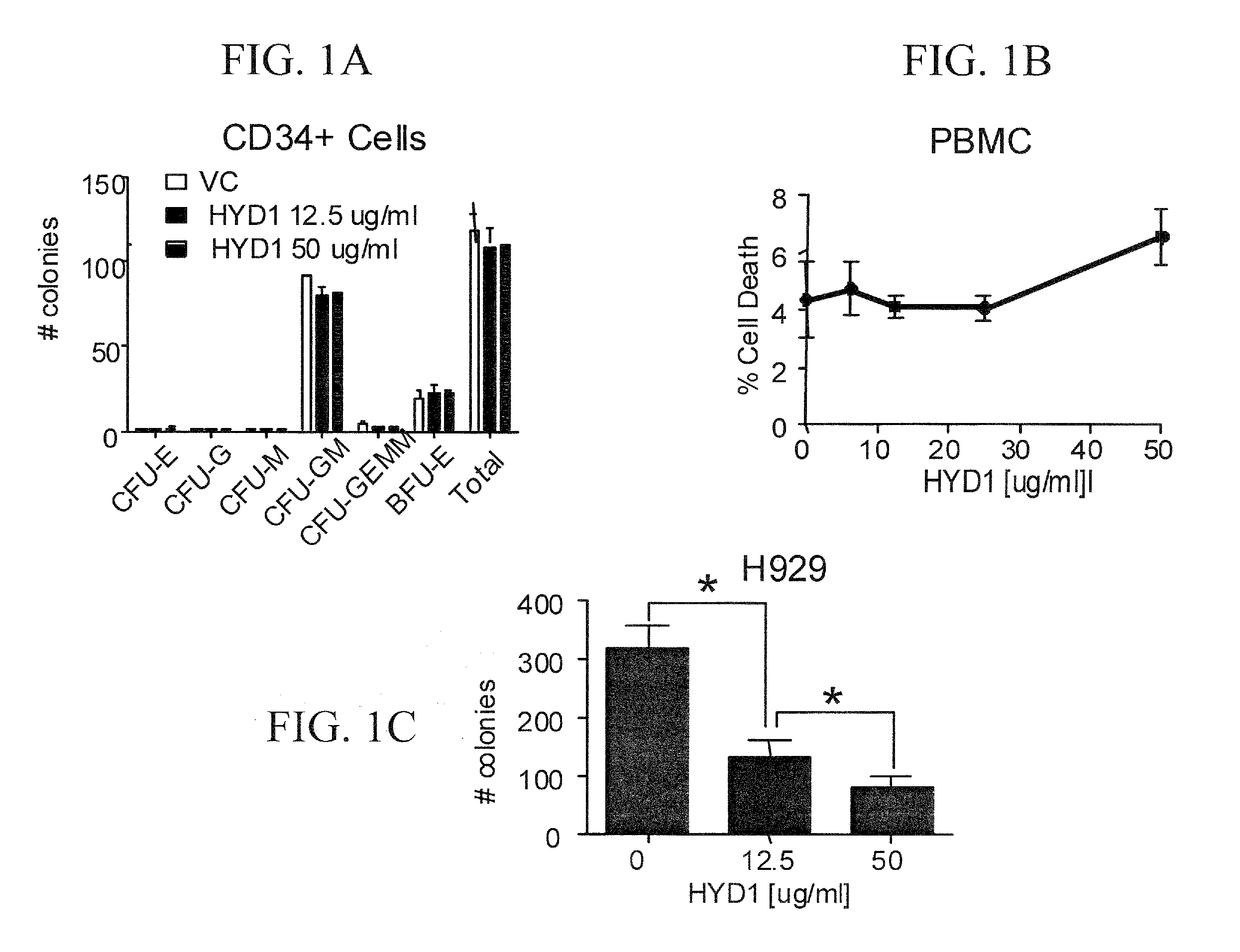Hyd1 peptides for relapsed cancer
- Summary
- Abstract
- Description
- Claims
- Application Information
AI Technical Summary
Benefits of technology
Problems solved by technology
Method used
Image
Examples
example 1
HYD1 is More Active in MM Cells Compared to Normal Cells
[0247]A colony forming assay was used to determine whether HYD1 induced cell death in normal hematopoietic cells. CD34+ hematopoietic progenitor cells were isolated from peripheral blood and treated for 2 hrs with HYD1 (12.5 and 50 μg / ml) and then plated in a methylcellulose media supplemented with growth factors supporting myeloid and erythroid colonies. Colonies were counted on day 12 post-plating. As shown in FIG. 1A, HYD1 did not inhibit colony formation of normal CD34+ cells. In addition, the inventors evaluated the toxicity of HYD1 in normal peripheral blood mononuclear cells (PBMC). As seen in FIG. 1B, six hours treatment with increasing concentration of HYD1 did not induce cell death up to doses of 50 μg / ml in PBMC. Finally as shown in FIG. 1C, and consistent with Topro-3 staining, HYD1 did inhibit colony formation of H929 cells at doses ranging from 12.5-50 ug / ml HYD1. Together, the data indicate that HYD1 targets MM c...
example 2
HYD1 Induces Necrotic Cell Death
[0248]HYD1-induced cell death is necrotic in nature as shown by: (a) a decrease in mitochondrial membrane potential (Δψm); (b) a loss of total cellular ATP, and; (c) an increase in reactive oxygen species (ROS) production. Moreover, HYD1 treatment does not result in apoptotic cell death as it did not trigger the activation of caspases or the release of apoptosis-inducing factor (AIF) and Endonuclease G (Endo G) from the mitochondria, nor did it induce double-stranded DNA breaks. HYD1 did initiate autophagy in cells; however, autophagy was found to be an adaptive response contributing to cell survival rather than the cause of cell death. The inventors were further able to show that N-acetyl-L-cysteine (NAC), a thiol containing free radical scavenger, partially protects MM cells from HYD1-induced death (Nair et al. 2009).
example 3
HYD1 Shows Activity as a Single Agent in the SCID-Hu In Vivo Model
[0249]The inventors used the SCID-hu model to determine whether HYD1 demonstrates anti-tumor activity in vivo. The SCID-hu model consists of implanting human fetal bone into the mammary mouse fat pad of SCID mice. The myeloma cells are subsequently injected directly into the bone and myeloma cells will engraft only in the area of the human bone. Human paraprotein can be measured in the mouse sera and levels represent a good marker for evaluating tumor burden and response to chemotherapy. Circulating kappa levels were measured on day 28 (baseline reading before peptide treatment), 35, 42 and 49 by ELISA, and tumor burden was determined by calculating the kappa levels on day X divided by the baseline kappa levels recorded on day 28 for each mouse. Shown in FIG. 2A is the antitumor response of H929 engrafted tumor when mice were given 8 mg / kg intraperitoneal (i.p.) injections daily for 21 days starting on day 28. Mice tr...
PUM
| Property | Measurement | Unit |
|---|---|---|
| Electrical resistance | aaaaa | aaaaa |
| Cytotoxicity | aaaaa | aaaaa |
Abstract
Description
Claims
Application Information
 Login to view more
Login to view more - R&D Engineer
- R&D Manager
- IP Professional
- Industry Leading Data Capabilities
- Powerful AI technology
- Patent DNA Extraction
Browse by: Latest US Patents, China's latest patents, Technical Efficacy Thesaurus, Application Domain, Technology Topic.
© 2024 PatSnap. All rights reserved.Legal|Privacy policy|Modern Slavery Act Transparency Statement|Sitemap



